Check out our buyer’s guide to the best dual extruder 3D printers on the market right now, from dual extrusion upgrades to IDEX 3D printers.
Here we shine a spotlight on the best out there. If you want (or need) to print more than mono-material, these dual extruder 3D printers are the ones to do it.
In this guide, we’ve picked the best dual extruder 3D printers ranging from dead-cheap budget prices to just south of one grand. But if you balk at the idea of purchasing a dedicated machine and happen to already be in possession of a perfectly fine 3D printer, we also have you covered with dual-extrusion upgrades at the bottom of this guide.
Naturally, there are also higher-priced machines for a more professional approach to dual extrusion 3D printing. If you need something along these lines, jump over to All3DP’s Pro Section and browse our professional dual extrusion guide:
For small- to medium-sized businesses, we would also recommend taking a closer look at our review of the Ultimaker S5, an excellent multi-material machine and the ultimate piece of hardware if you have some extra money to spend:
HOW TO PICK A DUAL EXTRUDER 3D PRINTER
Generally, dual extruder 3D printers can be divided into three categories: single-nozzle, dual-nozzle, and Independent Dual Extruder (IDEX).
In a single nozzle setup, the filament that is not active is retracted from the printhead. After a filament change, the nozzle has to be “purged” to ensure all of the previous material has been completely extruded. Unfortunately, ineffective purging can result in mixed or discolored material in the model, but larger purges waste more material and take more time.
Dual-nozzle printers have a single printhead, but two nozzles that extrude dependently. These generally allow for greater versatility and comparatively speedy multi-material prints; faster because less time is spent switching filaments and more versatile because the separate nozzles allow printing with varying nozzle diameters in a single print. Dual-nozzle printers do add a risk of oozing affecting your model, and that means you’ll likely need to print an ooze shield and prime tower. If you want to print with water-soluble support materials, one of these is usually the minimum to ensure none of that soluble material makes it into the models from ineffective purging.
IDEX systems, which entail two print heads that operate independently from one another, are the most versatile of the dual extruder 3D printers. Besides the possibility to use multiple materials like a dual-nozzle system, the independently operating print heads allow you to print two items simultaneously through duplication and mirroring print modes — that can make batch production a comparatively speedy endeavor. The biggest drawback here, besides the shared dual-nozzle problems, is the weight of an extra print head increasing the risk of Z-wobble.
When selecting a dual-extrusion 3D printer, think about what you want to accomplish. If you’re just looking to print in multiple colors, a single-nozzle system is likely most affordable and will keep upkeep to a minimum. If you want to print with soluble supports or different nozzle sizes, you might want to think about a dual-nozzle printer. And, if you’d like all of the above plus the ability to speed things up by printing two parts at the same time, IDEX may be the way to go. Just keep in mind price typically ascends in that order.
BEST DUAL EXTRUDER 3D PRINTERS
Geeetech A10M
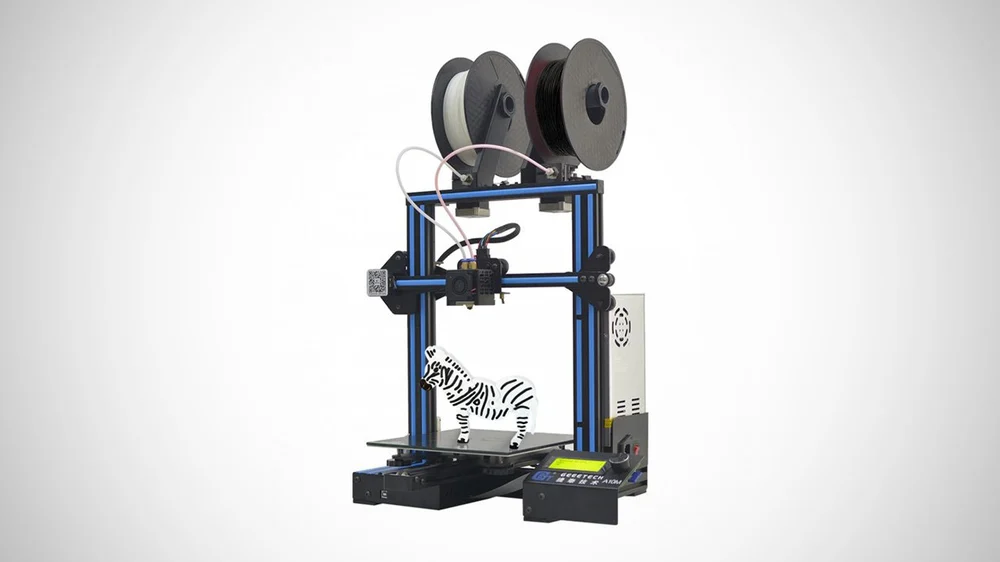
Piggybacking on a design popularized by Creality’s Ender 3, the Geeetech A10M plonks a cherry on top of that particular cake by adding dual extrusion.
Indeed, thanks to two extruders piping filament into the A10M’s single nozzle hotend, this 3D printer offers four printing modes: single color, dual color, graded color, and mixed color. You can lay down two different colors in succession (obviously) or, using Geeetech’s Color Mixer software, blend different colors to make new hues and shades.
It has a 220 x 220 x 260 mm build volume, which isn’t too shabby for a dual extrusion 3D printer priced under $200. And, with an open-source control board, the printer allows for additional upgrades such as auto-leveling or a Wi-Fi module.
By far the cheapest dual extrusion printer on this list, the Geeetech A10M is a prime example of just how far inexpensive printer kits have come in the last few years. We’re not saying it’s perfect, but with the price and promise of multi-color printing, it’s difficult to ignore.
For less frugaly-minded users, the bigger versions, Geeetech A20M and Geeetech A30M, might be enticing.
Sovol SV02
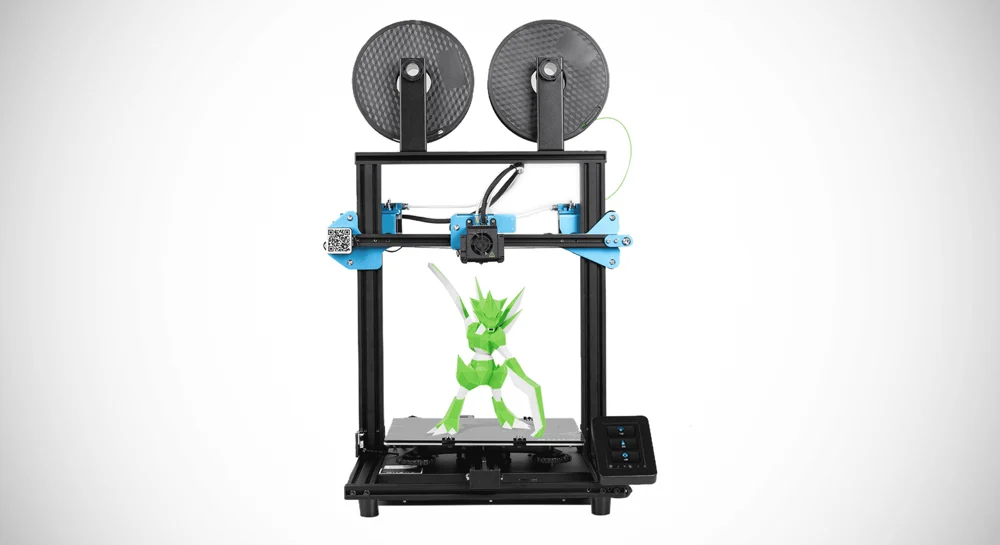
- Build Volume (mm) 280 x 240 x 300
- Prints via Single nozzle
- Print Heads 1
- Open Source Yes
- Third Party Filaments Yes
- Filament Size 1.75 mm
- Connectivity microSD, USB
- Market Price $259
Another Ender 3-like single nozzle dual extrusion 3D printer is the Sovol SV02. We think it’s a little sleeker than the Geeetech A10M with its touch screen interface and power supply tucked out of sight below the build plate, but there are a few other things that differentiate this printer.
The first thing you’d probably notice, compared to the A10M, is the slightly larger build volume. The Sovol SV02 sports a 240 x 220 x 300 mm build volume, granting users a bit more space to work their multi-material machinations. But also, the SV02 has a dedicated spot on the print head to install a BLTouch probe for auto bed-leveling. It’d be more tempting if ABL was included, but at least it makes the upgrade easy.
The SV02 is also missing some important features compared to the A10M, like the ability to mix filaments in its hot end — which is available by upgrading the hot end to Sovol’s “Mixing Hotend Dual Extruder” for ~$28.
If you’re looking for a different feature set on a single-nozzle dual-extrusion 3D printer, this one is worth considering. But, at $259 and without color mixing out of the box, we think it still lags behind the Geeetech A10M in terms of its value.
Geeetech A20T
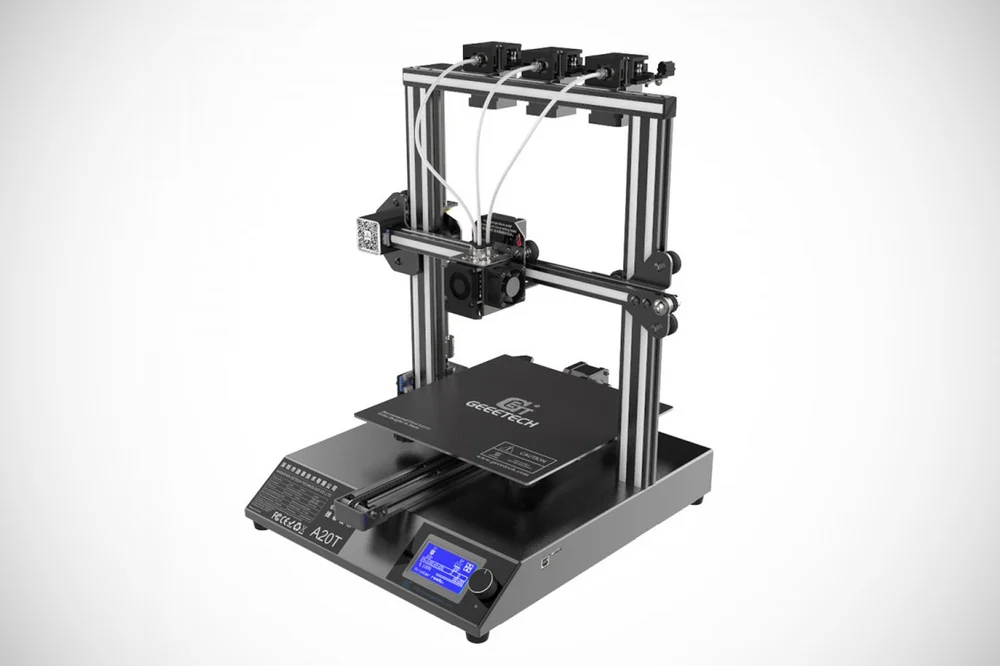
- Build Volume (mm) 250 x 250 x 250
- Prints via Single nozzle
- Print Heads 1
- Open Source Yes
- Third Party Filaments Yes
- Filament Size 1.75
- Connectivity SD, USB
- Market Price $415
What’s better than dual extrusion? Triple extrusion! Enter Geeetech’s three-in-one series. It looks like it belongs in a curio collection, and is definitely a rarity. Just like the aforementioned A10M, the triple extruder series of Geeetech comes in three different sizes. The A10T (220 x 220 x 250 mm), the A20T (250 x 250 x 250 mm) and the gigantic A30T (320 x 320 x 420 mm).
The two series are essentially identical, offering the same modes: single color, multi-color, graded color, and mixed color, except those hues will be even more colorful when you throw a third color into the mix. The hardware is all the same, but with a full aluminum base that hides the power supply.
Going over the counter for about $335, the A20T is similarly priced to Prusa’s MMU2, which – granted – can process up to five different colors, but then again, this gets you a complete printer and not just an add-on.
Tenlog TL-D3 Pro
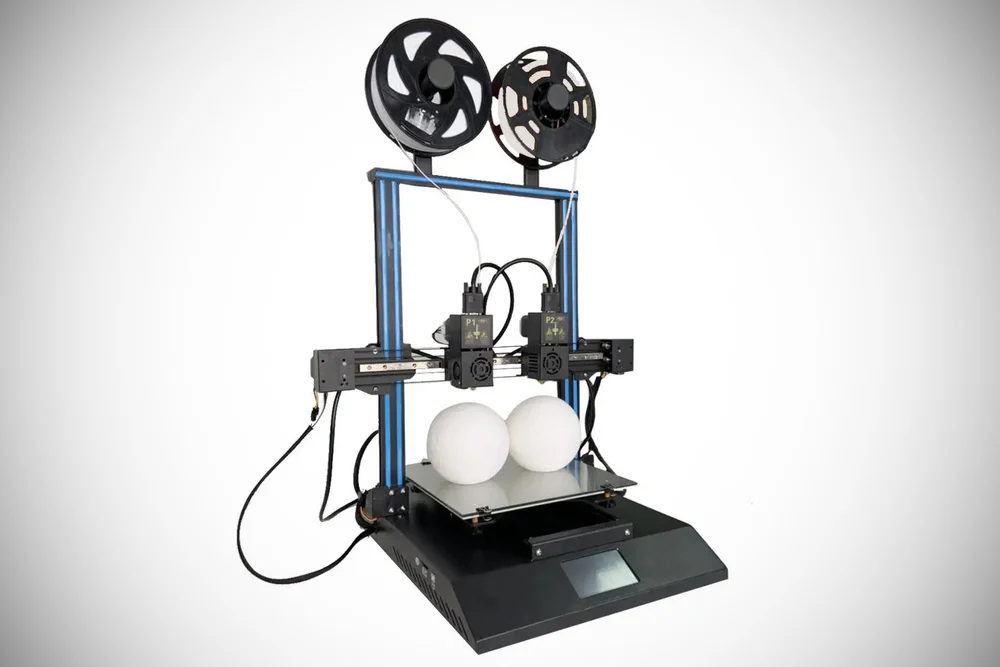
- Build Volume (mm) 300 x 300 x 350
- Prints via IDEX
- Print Heads 2
- Open Source Yes
- Third Party Filaments Yes
- Filament Size 1.75
- Connectivity SD card
- Market Price $560
The Tenlog TL-D3 Pro secures itself an entry on this list by offering IDEX technology at an accessible price of $560. An independent dual extrusion system (IDEX) is a feature not normally seen on printers geared towards consumers and hobbyists.
The TL-D3 Pro has a generous print volume of 300 x 300 x 350 mm. Good thing, too, since using the IDEX printer to produce mirrored prints effectively cuts its X-axis build volume in half.
Impressively, the Tenlog TL-D3 has accomplished its budget price point while also including a linear rail on the X-axis. Linear rails are often considered the most stable guide but are far more costly than V-slots to implement. Since IDEX systems add significant weight to the X-axis with a second print head, it’s an immensely useful feature to have on this printer. It’s also the reason Sovol’s similarly priced (but purely V-slot) IDEX offering, the SV04, didn’t make it onto this list.
Having not yet reviewed the printer ourselves, we found online feedback to be quite positive once you dialed the printer in a bit. An upgrade from the plain glass bed (not the best adhesion) to a tempered glass plate might be advisable. Otherwise, this thing should be good to go off the bat.
BIBO 3D Printer
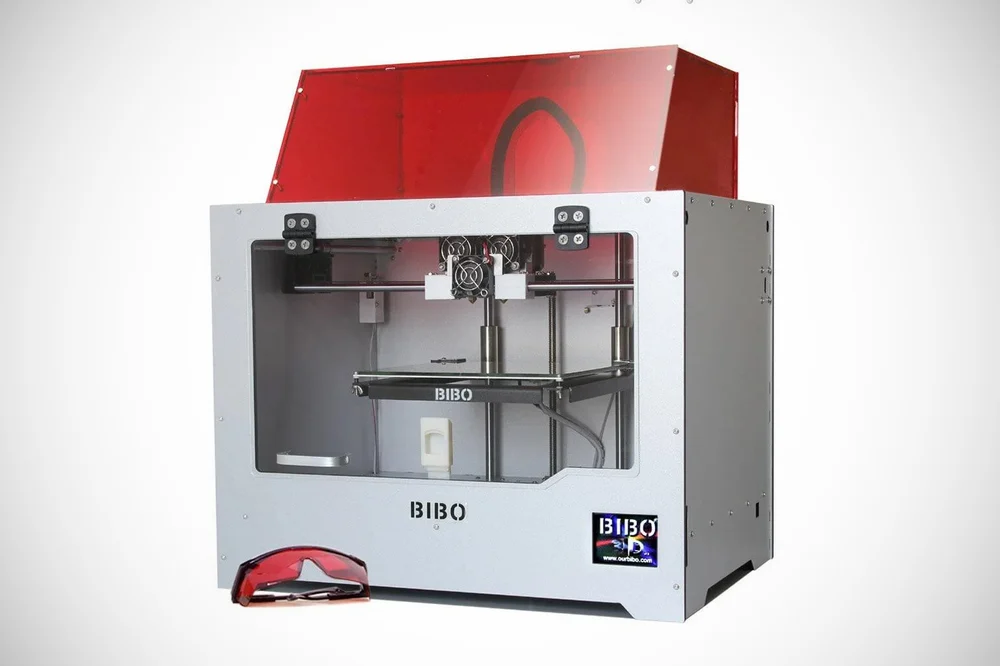
- Build Volume (mm) 214 x 186 x 160
- Prints via Dual nozzle
- Print Heads 1
- Open Source No
- Third Party Filaments Yes
- Filament Size 1.75 mm
- Connectivity WiFi, SD card, USB
- Special Features Heated bed, filament detection, laser engraving, WiFi, removable enclosed cover
- Market Price $550
The Bibo 3D printer (also extensively known as the Bibo 2) has cemented its place in Amazon’s bestseller rankings, picking up an overwhelmingly positive chunk of reviews in the process.
Appearance-wise, the Bibo 2 looks like it’s from a different era — but looks can be deceiving. Despite its ancient appearance, we were pleasantly surprised by the Bibo 2’s performance during our review.
Flashforge Creator Pro 2

- Build Volume (mm) 200 x 148 x 150
- Prints via IDEX
- Print Heads 2
- Open Source No
- Third Party Filaments Yes
- Filament Size 1.75
- Connectivity SD card, USB
- Market Price $900
Flashforge’s dual extrusion stalwart, the Creator Pro, finally received a meaningful upgrade in the Creator Pro 2; ditching the single print head design for a more advanced independent dual extrusion (IDEX) motion system.
Priced just south of $1,000, this alone helps the Creator Pro 2 stand out, as most similarly priced (dual extrusion) printers have to make do with a dual nozzle setup, limiting highly efficient production options like mirrored prints.
At 200 x 148 x 150 mm, the build volume can be considered a bit small, limiting the printing possibilities — especially if you are printing mirrored parts as the print bed’s X-axis is further split in half.
Small build volume aside, during our review we found the print quality to be generally fantastic, with the benefits of the new system showing strong in clean breaks between colors or materials. Combined with the ease of use and quality it offers out of the box, the Creator Pro 2 is a solid choice for a dual extrusion 3D printer.
BEST DUAL EXTRUSION UPGRADES
If you’re the lucky owner of specific 3D printers, you needn’t splash the cash on a whole new machine to start multi-material 3D printing. Here’s a quick list of add-on solutions for considerably less than the cost of the dual extrusion 3D printers listed above.
Mosaic Palette 3
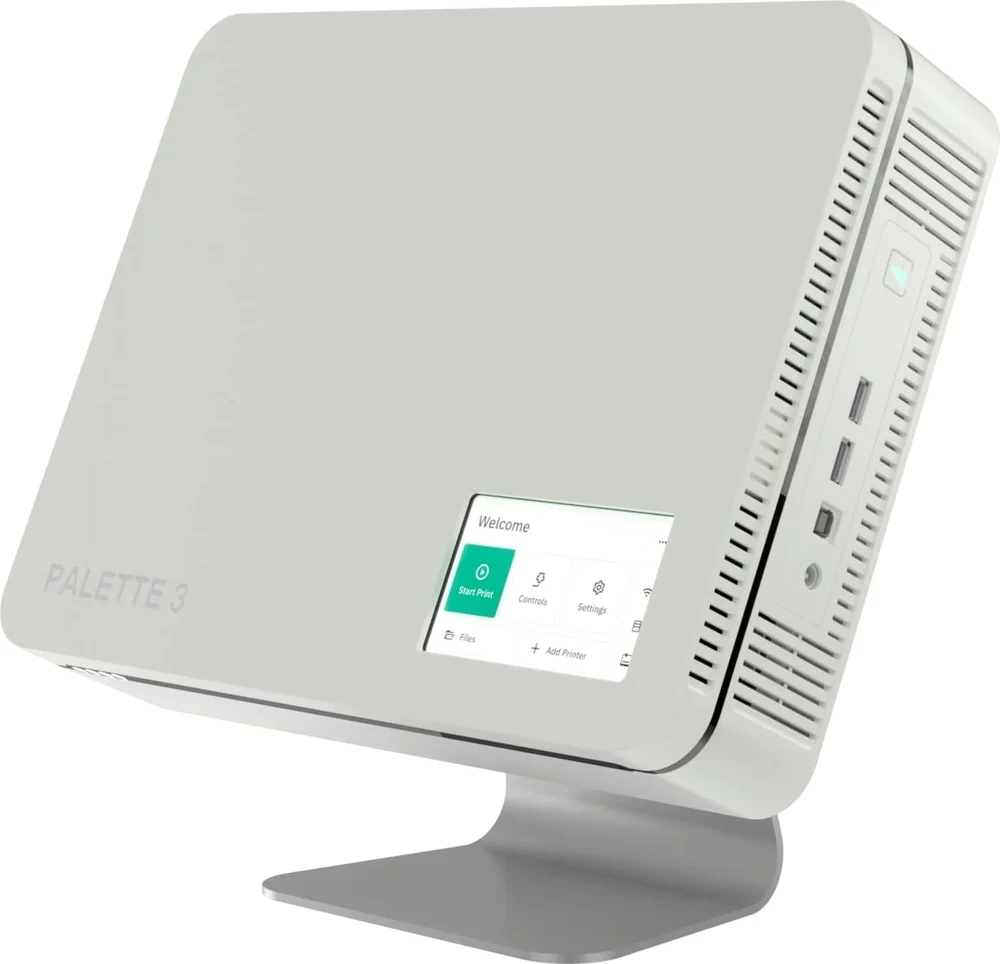
- Build Volume (mm) n.a.
- Prints via n.a.
- Print Heads n.a.
- Open Source No
- Third Party Filaments Yes
- Filament Size 1.75
- Connectivity USB, Wi-Fi
- Market Price $599
Bringing multi-material printing to the vast majority of 1.75 mm filament printing machines, the Mosaic Palette is perhaps the most versatile pre-packaged alternative to dumping a wedge of cash on a dedicated dual extrusion machine. Heck, it even outdoes dual extrusion with a possible input of four different filaments.
The Palette 3 intelligently splices filaments to feed a single, perfectly proportioned multi-color thread into your single nozzle printer, allowing for more creative and vibrant 3D prints. Constantly refining its novel multi-material 3D printing solution, the Mosaic is even compatible with flexible materials like TPU.
The Mosaic Palette 3 is accompanied by a Pro version, which boils down to double the material inputs (eight) and faster splicing speeds (10% higher than the standard Palette 3) as well as an extra year tacked on to the warranty. Whether the increased speed and longer warranty are worth the extra $200 completely depends on your personal preference.
Original Prusa MMU2S
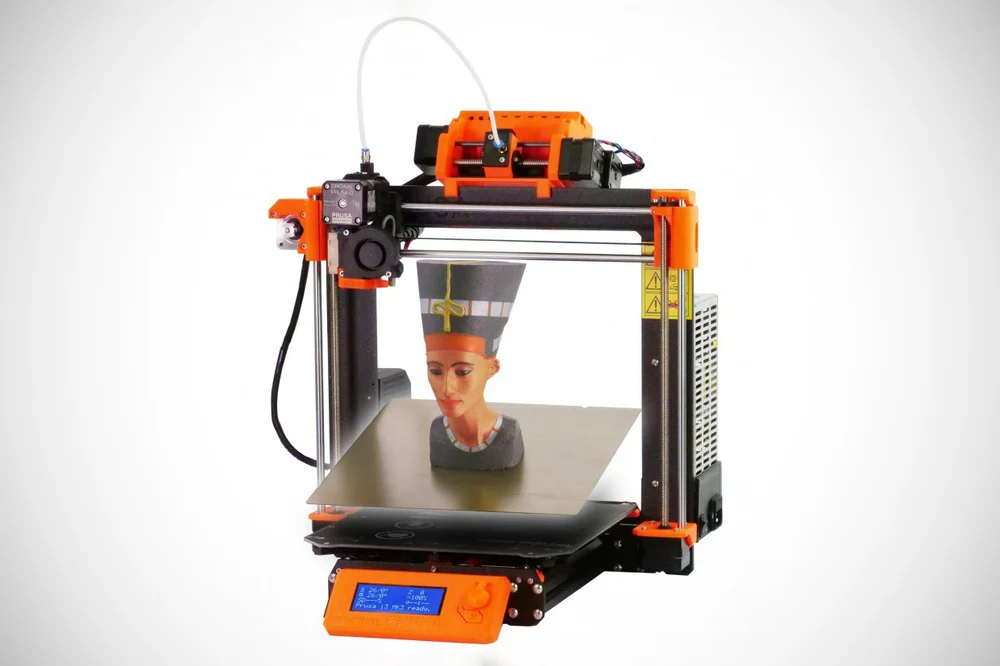
- Build Volume (mm) n.a.
- Prints via n.a.
- Print Heads n.a.
- Open Source No
- Third Party Filaments Yes
- Filament Size 1,75
- Connectivity n.a.
- Market Price ~$300
The MMU2S is an add-on for the hugely popular Original Prusa i3 MK3S+ and MK2.5S. It adds the ability to incorporate five different filaments, channeling them through the 3D printer’s single print head, as well as making printing with soluble support structures possible.
The latest version promises to have worked out some of its predecessor’s quirks — offering an easier calibration process, a new filament sensor, and a standalone filament buffer — making it easier to print the rainbow or combine different materials in a single print. However, it’s an advanced upgrade that requires patience to assemble, install, and get working correctly. Although it might not be the easiest Prusa upgrade, it’s worth the effort to get beautiful prints in the end.
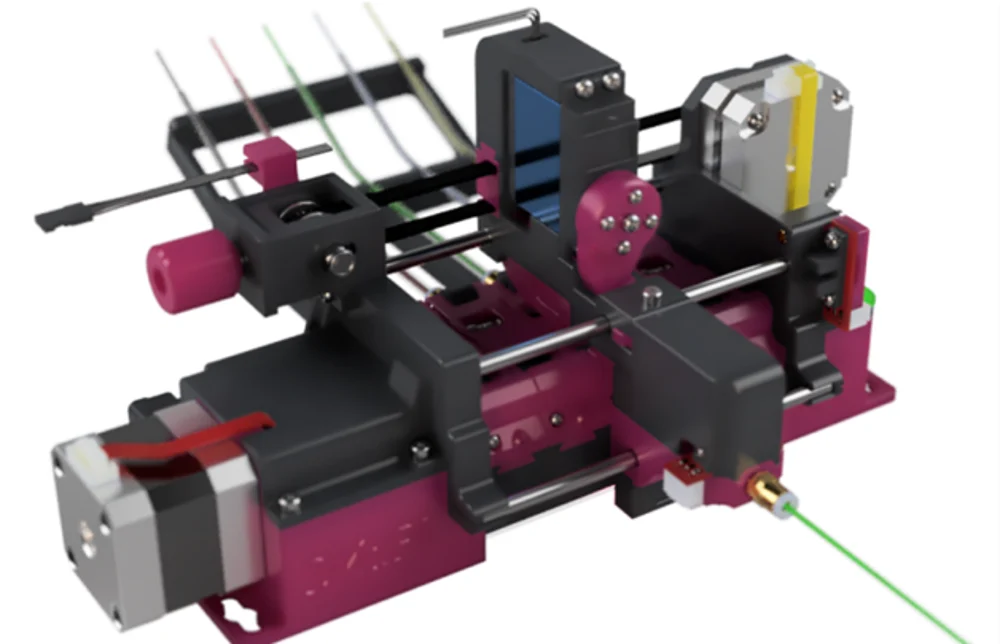
- Build Volume (mm) n.a.
- Prints via Single-extruder
- Print Heads n.a.
- Open Source Yes
- Third Party Filaments Yes
- Filament Size 1.75
- Connectivity USB-B, MicroSD (SKR Mini)
- Market Price n.a
The SMuFF V6 is an open-source DIY smart multi-filament feeder designed by Christian “Tecknik” Gegg. Much like Prusa’s MMU2S, the SMuFF is a selective filament feeder that allows users to incorporate multiple filaments into prints on a regular single nozzle 3D printer.
Unlike the MMU2S, the SMuFF V6 isn’t made for a particular 3D printer and is highly modular – meaning it can “use the same base for a 3, 5, 9 or even more materials machine (up to 12)”. It uses a Bondtech-style extruder instead of the 3D printer’s extruder in default mode, unless run in “MMU2 emulation mode” which requires a direct extruder on your 3D printer. The SMuFF runs its own electronics via an SKR Mini and uses Octoprint to operate, so it seems there’s no need to flash your 3D printer to use it – unless you’re using MMU2 emulation (which is necessary for Marlin 2.0.7.2).
It seems like an excellent solution, but it’s more involved than even the Prusa MMU2S. You need to be comfortable with some soldering and with configuring firmware. But, if you can get there, the SMuFF V6 seems like a very exciting DIY multi-filament 3D printing solution. Find the Thingiverse file or visit Gegg’s website for more information.
WHAT’S CHANGED?
This article used to be updated quarterly, meaning our recommendations could be anywhere up to three months out of date. That’s not so useful for buying advice, so we’ve binned that schedule and moved to a rolling update cycle. The moment we see a printer that deserves to be known, it goes on this list.
Just because a printer drops off this list does not mean it is bad, far from it. We’ll be keeping track of all the printers that have been removed and the printers that replaced them here so you can easily see our past top picks.
Update – February 2022: Our rankings didn’t change this time, but we added a top section that breaks down the differences between all the dual extrusion 3D printers out there so you can make an informed choice. The Sovol SV02 was added since it’s a competitive single-nozzle system and Geeetech was looking a little lonely at the top. The Mosaic Palette 2S was bumped up to the new Palette 3 and the SMuFF V6 was added to upgrades. We also removed the Qidi Tech X-Pro due to a lack of stock and significant price increases where it is still available for purchase.
June 2021: With this update, we wave off the Creality CR-X Pro. A 2-in-1, single nozzle 3D printer, which was discontinued. So far, we have no news from Creality if plans exist to release a follow-up version or any dual extrusion 3D printer for that matter. It is still available throughout some vendors if you want to pick it up on its way out.